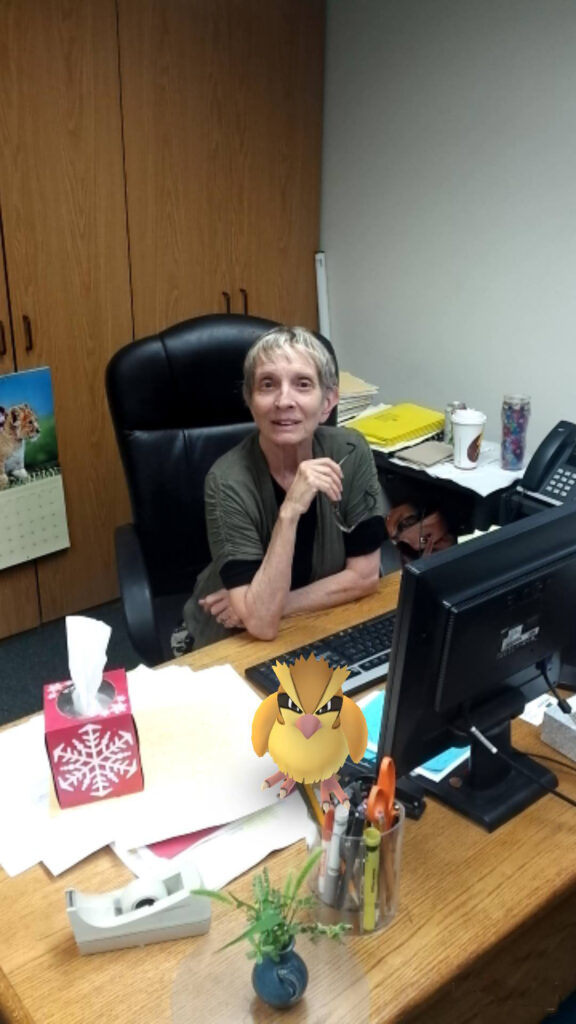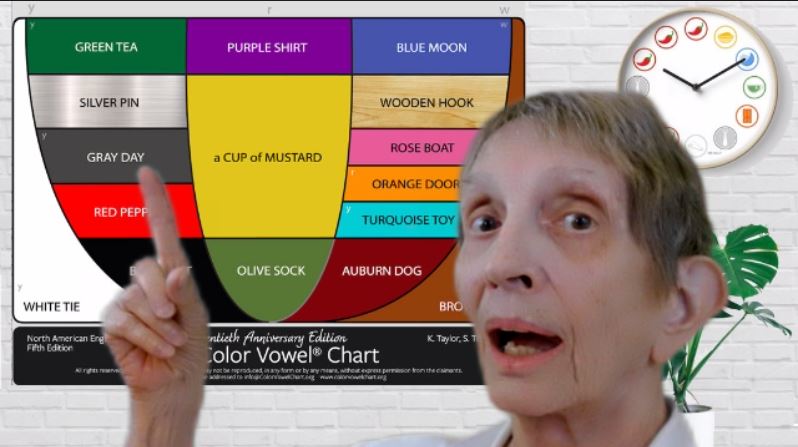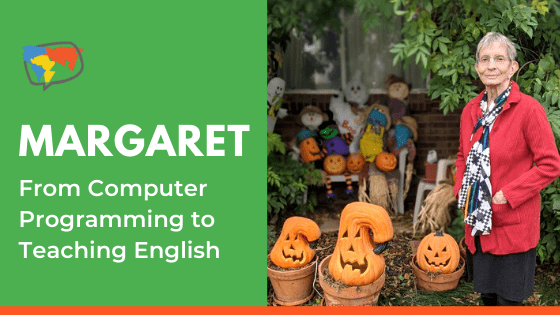Having worked in various sectors throughout her career, such as publishing and tech, Bridge grad Margaret Jones, from the U.S., leveraged her English and computer programming skills to embark on a journey in online English teaching. As a freelance ESL teacher, she has created a website to facilitate her students’ learning and to provide fellow educators with TEFL/TESOL resources. She discusses her decision to follow this new career path, her volunteer teaching experience, and her plans for further growth in the teaching field.
Can you share a bit about yourself?
I was born in Ohio but from 5th grade through high school and college I lived in Miami, Florida. I graduated from the University of Miami with a major in French and minors in German and Education. Then, I taught French in Atlanta, Georgia because my fiancé was going to GA Tech. We got married when he graduated. He entered the Air Force. We were stationed in Ohio. I was “back home” again. When he got out of the Air Force, since he was an aerospace engineer, we ended up in California, next in Colorado, then back to California, and, finally, back to Colorado again where, thank goodness, we were able to settle, buy a house, and give our family some stability.
Meanwhile, I picked up whatever work I could. I taught for a combined total of seven years, then ended up editing and publishing some small, technical journals. After that, my desktop publishing skills led me into investor relations, which is a branch of public relations. When the internet came along, this morphed into online publishing and creating websites. I found I was pretty good at computer languages as well as human languages. I ended up spending the past decade using mostly SQL, which is a database language, and I’ve been managing a small data warehouse.
Now that I’m 81, I think of myself as a Coloradoan – permanently.
What inspired you to become an English teacher?
Well, my husband and I had both been working from home remotely during COVID-19, which was actually quite nice. I did plan to go back to work in person in 2021, even though my work had become part-time during the 2020 pandemic. Then, on January 3, 2021, my husband died rather unexpectedly. I suddenly had to think, “How shall I plan to live for the rest of my life?” I’d seen ads for ESL and I thought, “This is something I can qualify for.” I’m free to travel once the pandemic is over, and I would really like to experience more countries. Plus, the trend is toward online classes and that’s something I’ll be able to offer long-term, hopefully, through not only my 80s but my 90s as well.
Find out how you can become a TEFL digital nomad.

You started teaching English online as a volunteer. How did you find this opportunity?
I knew there was a great need for immigrants in our area to learn English, but it was difficult getting started doing it online. Then, one civic group stated on their website that they could accommodate volunteers. However, this civic organization that got me started has since later had its budget slashed and has had to discontinue its ESL referrals. COVID-19 has been tough for everybody! But I’m continuing with my students, just by myself.
Another non-profit had had their activities curtailed during COVID-19 and were working as fast as they could to get an online program up and going.
Then, once I found a program that could take me, I found another problem. A lot of students have only a cell phone through which they can do online classes. And I hadn’t thought about the fact they might not have an unlimited data subscription! So, overall, there’s a large gap between the people who need ESL classes and the people who are in a position to furnish them. Nevertheless, I finally did get a student with good internet access, and she referred me to a couple of her friends, too.
Read more about why you should volunteer to teach English online and how you can find opportunities.
Can you tell us about the students you’re teaching nowadays?
So far, all my students are from Venezuela. I do speak some basic Spanish. And, even though it was France I went to one summer on a student exchange program, I have traveled a bit, briefly, in Spanish-speaking countries as a tourist. Plus, living in Denver, it’s around me all the time.
Anyway, all three students have wanted most to improve their verbal understanding and their pronunciation. So, that’s what I’ve stressed. As for vocabulary, one of my students is following a career in human resources, another is in marketing, and the third is experienced in import/export with quite a bit of accounting knowledge. Plus, my first two students have been working with other immigrants to help them learn English and study the facts they need to know to apply for citizenship.
So, when it comes to topics, I’ve given lessons centered around business and civics.
Do you have a teaching niche?
I decided early on when I was taking my Bridge courses that my best niche would be teaching Business English to adults. I’ve run my own small business in the past. And, also, when I was working in investor relations, I became quite familiar with the vocabulary and financials and ins-and-outs of many types of companies in a wide variety of industries. So, I think I have an exceptional amount to offer in the business niche. Nevertheless, I would gladly teach adults using whatever vocabulary they need.
Here are tips for choosing your TEFL niche.
How has online English teaching worked for you so far?
Teaching has been great! I do love working with computers. I can spend a day, all alone, designing complex SQL queries and be quite happy doing it. But it has really been nice working with people, again.
And I think that as I grow older, it is a good idea to keep more of this human dimension in my life.

You’ve created your own website for online English learners and teachers. Can you tell us more about it?
Bridge suggested we save some of the lesson plans, essay-type submissions, and so on created during TEFL/TESOL classes. The assignments also inspired me to research what adult business-type learners said they found most difficult in English, and the answer was reductions and phrasal verbs. Therefore, that’s what I developed during assignments.
So, I got the domain name LingoPractico.com, created a website, started my blog, and, under a “Portfolio” tab, saved lessons and exercises I was creating. When I started my Teaching English Online Practicum, the Off2Class website was a tremendous resource for a beginning teacher, but also my own creations gave me a boost when it came to supplementing the classes.
Although I’ve always had pretty clear English diction, myself, I had never studied English pronunciation in depth from an ESL standpoint in order to explain it to students. The Bridge TEFL/TESOL course I took inspired me to seek additional pronunciation resources online, which led me to the Color Vowel Chart. Under my Portfolio tab, I added a link to the interactive chart at the U.S. Dept. of State. This chart and pronunciation method turned out to be an absolute godsend when I started teaching!
There are lots of Color Vowel videos and materials aimed at teachers, and there’s a really good phone app for students. But there’s not a lot of exercises for use in an online class. So, obviously, I started making my own under my Portfolio tab.
Can you share a memorable or funny moment that you had as an English teacher?
There are always a lot of funny moments when you’re teaching a language. And there are a lot of “ah-ha!” moments for both the student AND the teacher. One “ah-ha” moment for me was when I realized that the letter “r” is really a vowel.
I was also happy one day in class when my student told me she’d been listening to a friend and could hear that he really did take the ending consonant from one word and stick it onto the beginning vowel of the next. She repeated the phrase back to him the way he was pronouncing it and, of course, as an American, he was surprised to learn he was saying it that way.

You took the 120-Hour Master Certificate and Teaching English Online Practicum. Why did you decide to take these courses?
Before signing up with a school, I did a lot of research. To get hired, ideally, you need a 120-hour TEFL/TESOL certificate plus a practicum, in addition to other qualifications such as a bachelor’s degree and a generic American accent, both of which I have.
-
There are many places offering quick and really inexpensive certification courses, often saying they are “endorsed” by this or that online body. But these certifications are not going to be taken seriously by anyone.
-
There are reputable universities offering really expensive certification courses, either along with or separate from degree classes. They are probably great, but no way could I ever afford them.
-
There are a few organizations that do not charge thousands of dollars but do have decent accreditation.
-
In addition, I wanted a company that really covered how to teach online. It needed to offer a practicum. I also decided the institution had to be on the Wiki list maintained by the Reddit TEFL group.
After narrowing it down to about half a dozen companies, I chose Bridge as the finalist I liked best. I would have done so even if they hadn’t happened to be in the same country, time zone, and state. That was a bit of serendipity.
Read these tips for choosing the best TEFL/TESOL certification course for you.
How did this course help you professionally?
First, I was really surprised to find Bridge and other good ESL websites teaching as “new” some of the concepts which were being introduced into foreign language teaching at the end of the ‘50s and beginning of the ‘60s:
-
Getting away from just memorizing rules of grammar, which is not a good way to learn to hear and speak a language.
-
Teaching the class totally in the target language using a lot of pictures, mime, and props.
-
Teaching a grammar concept by using patterns of speech that illustrate it and from which you can deduce the principle.
-
Teaching vocabulary in context rather than having students memorize long lists of words.
-
Devising exercises where the students, not the teacher, do a lot of talking.
-
Listening to the language in meaningful dialogs and stories.
The course was a wonderful review of good educational principles. It was especially valuable in updating me on the teaching resources available via the internet and what to consider when teaching remotely. But what on earth happened in the years I was away from language teaching? How did classrooms regress back to the early ’50s?
What’s next for you?
I’ve started looking for a paid online position and have applied to lots of places. I’ve heard back from only two.
One had some additional questions, which I answered and sent back, while the other responded with more details about their job, but I did not go any further with them. They looked like a good outfit but required that their work-from-home employees buy a 2000VA UPS (4- or 5-hour battery life), which costs $1,300 to $2,000 or more. With their job paying $6.00 per hour, that’s a lot of hours just to break even on the investment!
I’ve also compiled a vocabulary list of the most difficult and most often used words for my own use in creating materials. This is an ongoing project. Right now, it’s just on a Google Sheet. Ultimately, I may put it in a MySQL database. The next step is to add a column that applies the principles of the Lingua Franca Core. My “Portfolio” materials just keep growing and growing! The students are such an inspiration!










